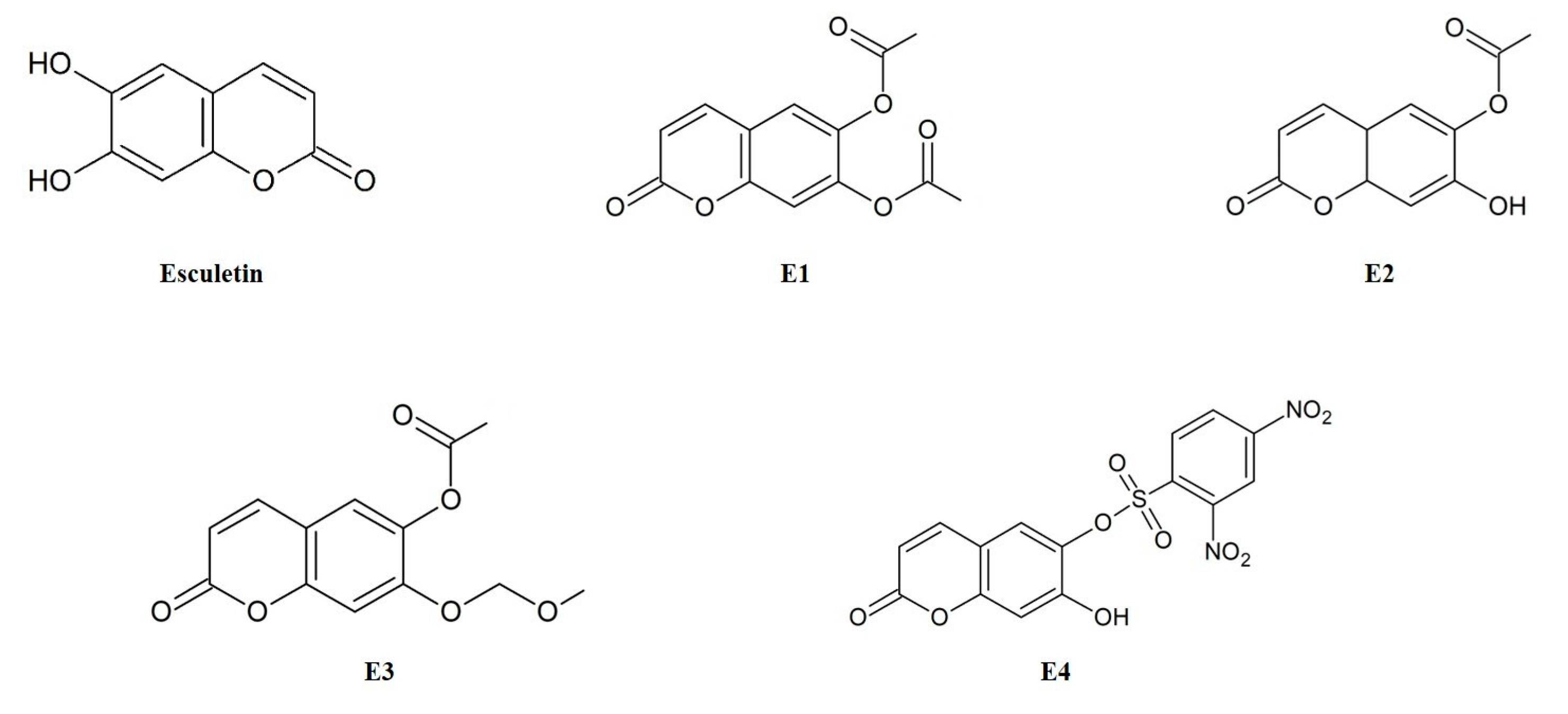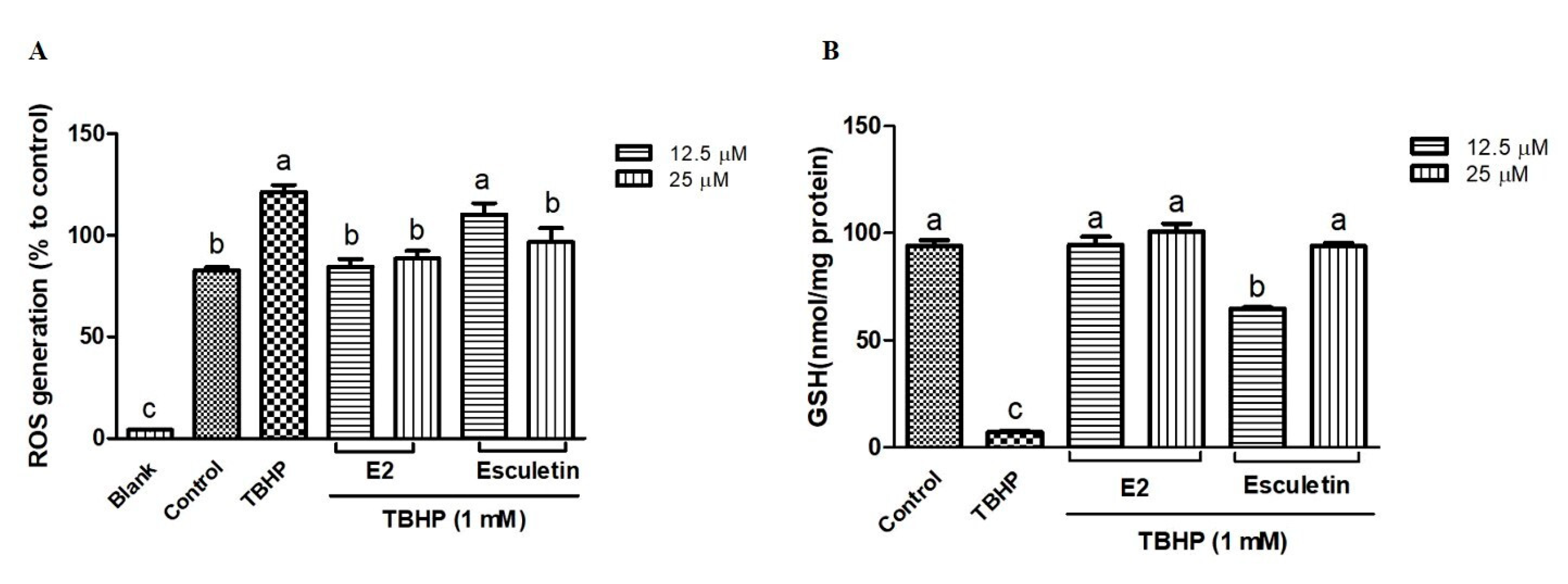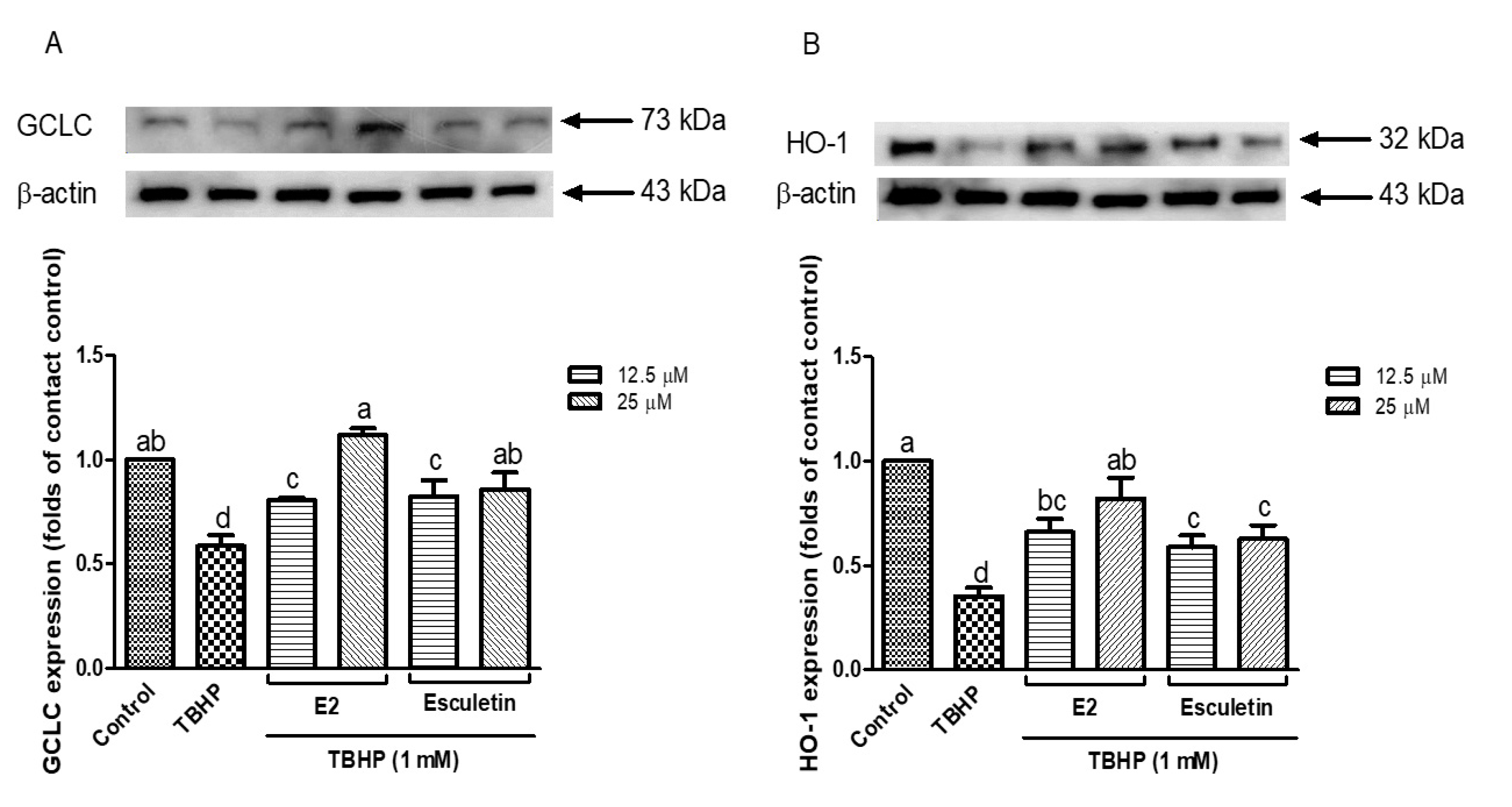Comparative Hepatoprotective Effects of Esculetin and Its Derivatives Against Oxidative Stress
Abstract
1. Introduction
2. Materials and Methods
2.1. Chemicals
2.2. Cell Culture
2.3. Cytotoxicity and Cytoprotective Effects
2.4. Measurement of ROS Generation
2.5. Determination of Glutathione Levels and Antioxidant Enzyme Activities
2.6. Western Blotting Analysis
2.7. Statistical Analysis
3. Results and Discussion
3.1. Effects of Esculetin and Its Derivatives on Cytotoxicity and Cytoprotection Against Oxidative Stress
3.2. Effects of Esculetin and Its Derivatives on Intracellular ROS Accumulation and GSH Depletion
3.3. Effects of Esculetin and Its Derivatives on the Antioxidant Enzyme Activities
4. Conclusions
Author Contributions
Funding
Institutional Review Board Statement
Informed Consent Statement
Data Availability Statement
Acknowledgments
Conflicts of Interest
Abbreviations
| BS | Bovine serum |
| CAT | Catalase |
| DMEM | Dulbecco’s modified Eagle’s medium |
| FBS | Fetal bovine serum |
| GPx | Glutathione peroxidase |
| GR | Glutathione reductase |
| GSH | Glutathione |
| MTT | 3-(4,5-dimethyl-thiazol-2-yl)-2,5-diphenyl-tetrazolium bromide |
| PBS | Phosphate-buffered saline |
| ROS | Reactive oxygen species |
| TBHP | tert-Butyl hydroperoxide |
References
- de Almeida, A.; de Oliveira, J.; da Silva Pontes, L.V.; de Souza Junior, J.F.; Goncalves, T.A.F.; Dantas, S.H.; de Almeida Feitosa, M.S.; Silva, A.O.; de Medeiros, I.A. ROS: Basic Concepts, Sources, Cellular Signaling, and its Implications in Aging Pathways. Oxid. Med. Cell. Longev. 2022, 2022, 1225578. [Google Scholar] [CrossRef]
- Srinivas, U.S.; Tan, B.W.Q.; Vellayappan, B.A.; Jeyasekharan, A.D. ROS and the DNA damage response in cancer. Redox Biol. 2019, 25, 101084. [Google Scholar] [CrossRef]
- Poprac, P.; Jomova, K.; Simunkova, M.; Kollar, V.; Rhodes, C.J.; Valko, M. Targeting Free Radicals in Oxidative Stress-Related Human Diseases. Trends Pharmacol. Sci. 2017, 38, 592–607. [Google Scholar] [CrossRef]
- Pizzino, G.; Irrera, N.; Cucinotta, M.; Pallio, G.; Mannino, F.; Arcoraci, V.; Squadrito, F.; Altavilla, D.; Bitto, A. Oxidative Stress: Harms and Benefits for Human Health. Oxid. Med. Cell. Longev. 2017, 2017, 8416763. [Google Scholar] [CrossRef]
- Aune, D. Plant Foods, Antioxidant Biomarkers, and the Risk of Cardiovascular Disease, Cancer, and Mortality: A Review of the Evidence. Adv. Nutr. 2019, 10, S404–S421. [Google Scholar] [CrossRef]
- Li, S.; Tan, H.Y.; Wang, N.; Zhang, Z.J.; Lao, L.; Wong, C.W.; Feng, Y. The Role of Oxidative Stress and Antioxidants in Liver Diseases. Int. J. Mol. Sci. 2015, 16, 26087–26124. [Google Scholar] [CrossRef]
- Arroyave-Ospina, J.C.; Wu, Z.; Geng, Y.; Moshage, H. Role of Oxidative Stress in the Pathogenesis of Non-Alcoholic Fatty Liver Disease: Implications for Prevention and Therapy. Antioxidants 2021, 10, 174. [Google Scholar] [CrossRef]
- Cho, J.H.; Shin, J.C.; Cho, J.J.; Choi, Y.H.; Shim, J.H.; Chae, J.I. Esculetin (6,7-dihydroxycoumarin): A potential cancer chemopreventive agent through suppression of Sp1 in oral squamous cancer cells. Int. J. Oncol. 2015, 46, 265–271. [Google Scholar] [CrossRef]
- Zhang, G.; Xu, Y.; Zhou, H.F. Esculetin Inhibits Proliferation, Invasion, and Migration of Laryngeal Cancer In Vitro and In Vivo by Inhibiting Janus Kinas (JAK)-Signal Transducer and Activator of Transcription-3 (STAT3) Activation. Med. Sci. Monit. 2019, 25, 7853–7863. [Google Scholar] [CrossRef]
- Wang, P.; Xia, Y.-L.; Yu, Y.; Lu, J.-X.; Zou, L.-W.; Feng, L.; Ge, G.-B.; Yang, L. Design, synthesis and biological evaluation of esculetin derivatives as anti-tumour agents. RSC Adv. 2015, 5, 53477–53483. [Google Scholar] [CrossRef]
- Yang, X.D.; Chen, Z.; Ye, L.; Chen, J.; Yang, Y.Y. Esculin protects against methionine choline-deficient diet-induced non-alcoholic steatohepatitis by regulating the Sirt1/NF-kappaB p65 pathway. Pharm. Biol. 2021, 59, 922–932. [Google Scholar] [CrossRef]
- Zhang, M.; Xin, X.; Lai, F.; Zhang, X.; Li, X.; Wu, H. Cellular Transport of Esculin and Its Acylated Derivatives in Caco-2 Cell Monolayers and Their Antioxidant Properties in Vitro. J. Agric. Food Chem. 2017, 65, 7424–7432. [Google Scholar] [CrossRef]
- Sharifi-Rad, J.; Cruz-Martins, N.; Lopez-Jornet, P.; Lopez, E.P.; Harun, N.; Yeskaliyeva, B.; Beyatli, A.; Sytar, O.; Shaheen, S.; Sharopov, F.; et al. Natural Coumarins: Exploring the Pharmacological Complexity and Underlying Molecular Mechanisms. Oxid. Med. Cell. Longev. 2021, 2021, 6492346. [Google Scholar] [CrossRef]
- Garg, S.S.; Gupta, J.; Sahu, D.; Liu, C.J. Pharmacological and Therapeutic Applications of Esculetin. Int. J. Mol. Sci. 2022, 23, 12643. [Google Scholar] [CrossRef]
- Kim, D.; Kim, Y.; Kim, Y. Effect of Purple Sweet Potato Using Different Cooking Methods on Cytoprotection against Ethanol-Induced Oxidative Damage through Nrf2 Activation in HepG2 Cells. Antioxidants 2023, 12, 1650. [Google Scholar] [CrossRef]
- Matos, M.J.; Mura, F.; Vazquez-Rodriguez, S.; Borges, F.; Santana, L.; Uriarte, E.; Olea-Azar, C. Study of coumarin-resveratrol hybrids as potent antioxidant compounds. Molecules 2015, 20, 3290–3308. [Google Scholar] [CrossRef]
- Fakri Mustafa, Y.; Riyadh Khalil, R.; Tareq Mohammed, E.; Bashir, M.K.; Khudhayer Oglah, M. Effects of structural manipulation on the bioactivity of some coumarin-based products. Arch. Razi Inst. 2021, 76, 1297–1305. [Google Scholar] [CrossRef]
- Park, T.; Park, J.S.; Sim, J.H.; Kim, S.Y. 7-Acetoxycoumarin inhibits LPS-induced inflammatory cytokine synthesis by IκBα degradation and MAPK activation in macrophage cells. Molecules 2020, 25, 3124. [Google Scholar] [CrossRef]
- Tsai, H.Y.; Yang, J.F.; Chen, Y.B.; Guo, J.L.; Li, S.; Wei, G.J.; Ho, C.T.; Hsu, J.L.; Chang, C.I.; Liang, Y.S.; et al. Acetylation enhances the anticancer activity and oral bioavailability of 5-demethyltangeretin. Int. J. Mol. Sci. 2022, 23, 13284. [Google Scholar] [CrossRef]
- Zhang, L.; Xie, Q.; Li, X. Esculetin: A review of its pharmacology and pharmacokinetics. Phytother. Res. 2022, 36, 279–298. [Google Scholar] [CrossRef]
- Subramaniam, S.R.; Ellis, E.M. Esculetin-induced protection of human hepatoma HepG2 cells against hydrogen peroxide is associated with the Nrf2-dependent induction of the NAD(P)H: Quinone oxidoreductase 1 gene. Toxicol. Appl. Pharmacol. 2011, 250, 130–136. [Google Scholar] [CrossRef] [PubMed]
- Kim, S.H.; Kang, K.A.; Zhang, R.; Piao, M.J.; Ko, D.O.; Wang, Z.H.; Chae, S.W.; Kang, S.S.; Lee, K.H.; Kang, H.K.; et al. Protective effect of esculetin against oxidative stress-induced cell damage via scavenging reactive oxygen species. Acta Pharmacol. Sin. 2008, 29, 1319–1326. [Google Scholar] [CrossRef]
- Prabakaran, D.; Ashokkumar, N. Protective effect of esculetin on hyperglycemia-mediated oxidative damage in the hepatic and renal tissues of experimental diabetic rats. Biochimie 2013, 95, 366–373. [Google Scholar] [CrossRef] [PubMed]
- Jung, W.K.; Park, S.B.; Yu, H.Y.; Kim, Y.H.; Kim, J. Antioxidant Efficacy of Esculetin against Tert-Butyl Hydroperoxide-Induced Oxidative Stress in HEK293 Cells. Curr. Issues Mol. Biol. 2022, 44, 5986–5994. [Google Scholar] [CrossRef] [PubMed]
- Rubio, V.; Garcia-Perez, A.I.; Tejedor, M.C.; Herraez, A.; Diez, J.C. Esculetin Neutralises Cytotoxicity of t-BHP but Not of H(2)O(2) on Human Leukaemia NB4 Cells. BioMed Res. Int. 2017, 2017, 9491045. [Google Scholar] [CrossRef]
- Gerasimova, E.; Gazizullina, E.; Radosteva, E.; Ivanova, A. Antioxidant and antiradical properties of some examples of flavonoids and coumarins—Potentiometric studies. Chemosensors 2021, 9, 112. [Google Scholar] [CrossRef]
- Katopodi, A.; Tsotsou, E.; Iliou, T.; Deligiannidou, G.E.; Pontiki, E.; Kontogiorgis, C.; Tsopelas, F.; Detsi, A. Synthesis, Bioactivity, Pharmacokinetic and Biomimetic Properties of Multi-Substituted Coumarin Derivatives. Molecules 2021, 26, 5999. [Google Scholar] [CrossRef]
- Chen, C.; Wang, P.; Zou, L.; Yang, L.; Fan, Y.; Hu, W.; Ge, G. Synthesis and biological evaluation of hydroxylcoumarin derivatives as antioxidant agents. Chem. Res. Chin. Univ. 2017, 33, 194–199. [Google Scholar] [CrossRef]
- Sollai, F.; Zucca, P.; Sanjust, E.; Steri, D.; Rescigno, A. Umbelliferone and esculetin: Inhibitors or substrates for polyphenol oxidases? Biol. Pharm. Bull. 2008, 31, 2187–2193. [Google Scholar] [CrossRef]
- Wang, Q.H.; Qin, S.W.; Jiang, J.G. Improvement effects of esculetin on the formation and development of atherosclerosis. Biomed. Pharmacother. 2022, 150, 113001. [Google Scholar] [CrossRef]
- Shih, M.K.; Tain, Y.L.; Cheng, C.M.; Hsu, C.N.; Chen, Y.W.; Huang, H.T.; Chang, C.I.; Hou, C.Y. Separation and identification of resveratrol butyrate ester complexes and their bioactivity in HepG2 cell models. Int. J. Mol. Sci. 2021, 22, 13539. [Google Scholar] [CrossRef]
- Tain, Y.L.; Jheng, L.C.; Chang, S.K.; Chen, Y.W.; Huang, L.T.; Liao, J.X.; Hou, C.-Y. Synthesis and characterization of novel resveratrol butyrate esters that have the ability to prevent fat accumulation in a liver cell culture model. Molecules 2020, 25, 4199. [Google Scholar] [CrossRef]
- Torrisi, C.; Malfa, G.A.; Acquaviva, R.; Castelli, F.; Sarpietro, M.G. Effect of protocatechuic acid ethyl ester on biomembrane models: Multilamellar vesicles and monolayers. Membranes 2022, 12, 283. [Google Scholar] [CrossRef] [PubMed]
- Hu, J.N.; Zou, X.G.; He, Y.; Chen, F.; Deng, Z.Y. Esterification of quercetin increases its transport across human Caco-2 cells. J. Food Sci. 2016, 81, H1825–H1832. [Google Scholar] [CrossRef]
- Sakao, K.; Saruwatari, H.; Minami, S.; Hou, D.X. Hydroxyl group acetylation of quercetin enhances intracellular absorption and persistence to upregulate anticancer activity in HepG2 cells. Int. J. Mol. Sci. 2023, 24, 16652. [Google Scholar] [CrossRef]
- Urakawa, D.; Shioiridani, Y.; Igata, S.; Hou, D.X.; Sakao, K. Comparative analysis of acetylated flavonoids’ chemopreventive effects in different cancer cell lines. Int. J. Mol. Sci. 2024, 25, 7689. [Google Scholar] [CrossRef] [PubMed]
- Witaicenis, A.; Seito, L.N.; da Silveira Chagas, A.; de Almeida, L.D., Jr.; Luchini, A.C.; Rodrigues-Orsi, P.; Cestari, S.H.; Di Stasi, L.C. Antioxidant and intestinal anti-inflammatory effects of plant-derived coumarin derivatives. Phytomedicine 2014, 21, 240–246. [Google Scholar] [CrossRef] [PubMed]
- Kim, K.H.; Park, H.; Park, H.J.; Choi, K.H.; Sadikot, R.T.; Cha, J.; Joo, M. Glycosylation enables aesculin to activate Nrf2. Sci. Rep. 2016, 6, 29956. [Google Scholar] [CrossRef]
- Medina, F.G.; Marrero, J.G.; Macias-Alonso, M.; Gonzalez, M.C.; Cordova-Guerrero, I.; Teissier Garcia, A.G.; Osegueda-Robles, S. Coumarin heterocyclic derivatives: Chemical synthesis and biological activity. Nat. Prod. Rep. 2015, 32, 1472–1507. [Google Scholar] [CrossRef]
- Bhattarai, N.; Kumbhar, A.A.; Pokharel, Y.R.; Yadav, P.N. Anticancer Potential of Coumarin and its Derivatives. Mini-Rev. Med. Chem. 2021, 21, 2996–3029. [Google Scholar] [CrossRef]
- Pompella, A.; Visvikis, A.; Paolicchi, A.; De Tata, V.; Casini, A.F. The changing faces of glutathione, a cellular protagonist. Biochem. Pharmacol. 2003, 66, 1499–1503. [Google Scholar] [CrossRef] [PubMed]
- Kim, Y.; Lee, J. Esculetin Inhibits Adipogenesis and Increases Antioxidant Activity during Adipocyte Differentiation in 3T3-L1 Cells. Prev. Nutr. Food Sci. 2017, 22, 118–123. [Google Scholar] [CrossRef] [PubMed]
- Lin, H.C.; Tsai, S.H.; Chen, C.S.; Chang, Y.C.; Lee, C.M.; Lai, Z.Y.; Lin, C.M. Structure-activity relationship of coumarin derivatives on xanthine oxidase-inhibiting and free radical-scavenging activities. Biochem. Pharmacol. 2008, 75, 1416–1425. [Google Scholar] [CrossRef]
- Kurma, S.H.; Karri, S.; Kuncha, M.; Sistla, R.; Bhimapaka, C.R. Synthesis and anti-inflammatory activity of 2-oxo-2H-chromenyl and 2H-chromenyl-5-oxo-2,5-dihydrofuran-3-carboxylates. Bioorg. Med. Chem. Lett. 2020, 30, 127341. [Google Scholar] [CrossRef]
- Luo, Y.; Chang, T.; Huang, S.; Xiang, J.; Tang, S.; Shen, H. Protective effects and mechanisms of esculetin against H2O2-induced oxidative stress, apoptosis, and pyroptosis in human hepatoma HepG2 cells. Molecules 2024, 29, 1415. [Google Scholar] [CrossRef]
- Filipsky, T.; Riha, M.; Macakova, K.; Anzenbacherova, E.; Karlickova, J.; Mladenka, P. Antioxidant effects of coumarins include direct radical scavenging, metal chelation and inhibition of ROS-producing enzymes. Curr. Top. Med. Chem. 2015, 15, 415–431. [Google Scholar] [CrossRef]
- Yang, Y.; Tan, W.; Zhang, J.; Guo, Z.; Jiang, A.; Li, Q. Novel coumarin-functionalized inulin derivatives: Chemical modification and antioxidant activity assessment. Carbohydr. Res. 2022, 518, 108597. [Google Scholar] [CrossRef] [PubMed]
- Sun, J.; Xu, L.; Pan, Q.; Wang, P.; Zhang, Q.; Wang, P.; Xia, Y. Coumarin derivatives as inhibitors against monoamine oxidase: Structure-activity relationships and inhibitory mechanisms. Acta Mater. Medica 2025, 4, 262–279. [Google Scholar] [CrossRef]
- Zhang, H.; Davies, K.J.A.; Forman, H.J. Oxidative stress response and Nrf2 signaling in aging. Free Radic. Biol. Med. 2015, 88, 314–336. [Google Scholar] [CrossRef]
- Hassanein, E.H.M.; Sayed, A.M.; Hussein, O.E.; Mahmoud, A.M. Coumarins as Modulators of the Keap1/Nrf2/ARE Signaling Pathway. Oxid. Med. Cell. Longev. 2020, 2020, 1675957. [Google Scholar] [CrossRef]
- Xia, M.; Wu, Z.; Wang, J.; Buist-Homan, M.; Moshage, H. The Coumarin-Derivative Esculetin Protects against Lipotoxicity in Primary Rat Hepatocytes via Attenuating JNK-Mediated Oxidative Stress and Attenuates Free Fatty Acid-Induced Lipid Accumulation. Antioxidants 2023, 12, 1922. [Google Scholar] [CrossRef] [PubMed]
- Jomova, K.; Raptova, R.; Alomar, S.Y.; Alwasel, S.H.; Nepovimova, E.; Kuca, K.; Valko, M. Reactive oxygen species, toxicity, oxidative stress, and antioxidants: Chronic diseases and aging. Arch. Toxicol. 2023, 97, 2499–2574. [Google Scholar] [CrossRef]
- Yavari, A.; Javadi, M.; Mirmiran, P.; Bahadoran, Z. Exercise-induced oxidative stress and dietary antioxidants. Asian J. Sports Med. 2015, 6, e24898. [Google Scholar] [CrossRef]
- Alvarado, C.; Alvarez, P.; Puerto, M.; Gausseres, N.; Jimenez, L.; De la Fuente, M. Dietary supplementation with antioxidants improves functions and decreases oxidative stress of leukocytes from prematurely aging mice. Nutrition 2006, 22, 767–777. [Google Scholar] [CrossRef]
- Chang, K.-M.; Chen, H.-H.; Wang, T.-C.; Chen, I.-L.; Chen, Y.-T.; Yang, S.-C.; Chen, Y.-L.; Chang, H.-H.; Huang, C.-H.; Chang, J.-Y. Novel oxime-bearing coumarin derivatives act as potent Nrf2/ARE activators in vitro and in mouse model. Eur. J. Med. Chem. 2015, 106, 60–74. [Google Scholar] [CrossRef] [PubMed]
- Zhang, Y.; An, Y.; He, X.; Zhang, D.; He, W. Esculetin protects human corneal epithelial cells from oxidative stress through Nrf-2 signaling pathway. Exp. Eye Res. 2021, 202, 108360. [Google Scholar] [CrossRef] [PubMed]
- Ozalp, L.; Danış, Ö.; Yuce-Dursun, B.; Demir, S.; Gündüz, C.; Ogan, A. Investigation of HMG-CoA reductase inhibitory and antioxidant effects of various hydroxycoumarin derivatives. Arch. Pharm. 2020, 353, 1900378. [Google Scholar] [CrossRef]
- Lee, C.Y.; Nanah, C.N.; Held, R.A.; Clark, A.R.; Huynh, U.G.; Maraskine, M.C.; Uzarski, R.L.; McCracken, J.; Sharma, A. Effect of electron donating groups on polyphenol-based antioxidant dendrimers. Biochimie 2015, 111, 125–134. [Google Scholar] [CrossRef]




| Treatment | GR (nmol/min/mg of Protein) | GPx (nmol/min/mg of Protein) | CAT (μmol/min/mg of Protein) | |
|---|---|---|---|---|
| Control | 8.461 ± 1.200 c | 8.160 ± 1.133 d | 6.000 ± 0.470 c | |
| TBHP (1 mM) | 4.335 ± 0.903 d | 27.222 ± 3.040 a | 6.622 ± 1.161 a | |
| TBHP (1 mM) | E2 (12.5 μM) | 12.041 ± 1.454 a | 21.343 ± 2.464 b | 5.556 ± 0.427 b |
| E2 (25 μM) | 10.238 ± 0.441 b | 14.145 ± 2.890 c | 5.156 ± 0.364 c | |
| Esculetin (12.5 μM) | 10.213 ± 1.032 b | 27.467 ± 2.479 a | 5.689 ± 0.524 a | |
| Esculetin (25 μM) | 10.006 ± 1.372 b | 13.528 ± 2.409 c | 5.289 ± 0.393 c | |
Disclaimer/Publisher’s Note: The statements, opinions and data contained in all publications are solely those of the individual author(s) and contributor(s) and not of MDPI and/or the editor(s). MDPI and/or the editor(s) disclaim responsibility for any injury to people or property resulting from any ideas, methods, instructions or products referred to in the content. |
© 2025 by the authors. Licensee MDPI, Basel, Switzerland. This article is an open access article distributed under the terms and conditions of the Creative Commons Attribution (CC BY) license (https://creativecommons.org/licenses/by/4.0/).
Share and Cite
Kim, Y.; Kwon, J.; Kwak, J.-H.; Baek, I.-h.; Kim, Y. Comparative Hepatoprotective Effects of Esculetin and Its Derivatives Against Oxidative Stress. Antioxidants 2025, 14, 787. https://doi.org/10.3390/antiox14070787
Kim Y, Kwon J, Kwak J-H, Baek I-h, Kim Y. Comparative Hepatoprotective Effects of Esculetin and Its Derivatives Against Oxidative Stress. Antioxidants. 2025; 14(7):787. https://doi.org/10.3390/antiox14070787
Chicago/Turabian StyleKim, Yoonjeong, Jihyun Kwon, Jae-Hwan Kwak, In-hwan Baek, and Younghwa Kim. 2025. "Comparative Hepatoprotective Effects of Esculetin and Its Derivatives Against Oxidative Stress" Antioxidants 14, no. 7: 787. https://doi.org/10.3390/antiox14070787
APA StyleKim, Y., Kwon, J., Kwak, J.-H., Baek, I.-h., & Kim, Y. (2025). Comparative Hepatoprotective Effects of Esculetin and Its Derivatives Against Oxidative Stress. Antioxidants, 14(7), 787. https://doi.org/10.3390/antiox14070787







